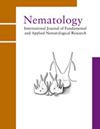内生真菌通过增强防御相关基因的表达来改善香蕉洞穴线虫的管理
IF 1.2
4区 生物学
Q2 ZOOLOGY
引用次数: 5
摘要
根穴线虫(Radopholus similis)据称是香蕉最具破坏性的线虫害虫,造成重大生产损失。在这项研究中,对13株真菌分离株的内生潜力进行了评估,以用于东非高原香蕉(' Ng ' ombe ')的相似镰刀菌管理。所有分离株都成功定植在组织培养的香蕉根上,其中木霉、镰刀菌和Hypocrea分离株的定植量最高(大于或小于49.1%),而Beauveria分离株的定植量最低(≥14.4%)。与未接种对照相比,真菌内生菌asperellum (ICIPE 700)和H. lixii (ICIPE 697)对相似田鼠密度的降低效果最显著(达81%)。然而,与单独接种相比,联合接种icipe700和icipe697对相似弧菌的抑制作用更大(约21%)。用ICIPE 700和(或)ICIPE 697接种香蕉根后,相似黑螺旋体的抑制与防御相关基因PR-1、细胞信号基因钙调蛋白Ca2+和细胞壁强化基因β-1,3-葡聚糖合酶的显著上调有关。这项研究证明了在具有真菌内生菌的香蕉中进行线虫管理的潜力,特别是结合使用分离株ICIPE 700和ICIPE 697。本文章由计算机程序翻译,如有差异,请以英文原文为准。
Endophytic fungi improve management of the burrowing nematode in banana (Musa spp.) through enhanced expression of defence-related genes
The root-burrowing nematode, Radopholus similis, is reputedly the most damaging nematode pest of banana and responsible for major production losses. In this study, the endophytic potential of 13 fungal isolates was assessed for the management of R. similis in East African Highland bananas (‘Ng’ombe’). All isolates successfully colonised tissue-cultured banana roots, with isolates from Trichoderma, Fusarium and Hypocrea producing the highest (⩾49.1%) and Beauveria isolates the lowest (⩽14.4%) colonisation. The fungal endophytes T. asperellum (ICIPE 700) and H. lixii (ICIPE 697) were the most effective in reducing R. similis densities (>81%) relative to the non-inoculated control. However, the combined inoculation of ICIPE 700 and ICIPE 697 led to greater suppression of R. similis (>21%) relative to individual inoculation. Suppression of R. similis following inoculation of banana roots with ICIPE 700 and/or ICIPE 697 was associated with the significant upregulation of the defence-related gene PR-1, the cell signalling gene calmodulin Ca2+ and the cell-wall-strengthening gene β-1,3-glucan synthase. This study demonstrates the potential for nematode management in bananas with fungal endophytes, especially using the isolates ICIPE 700 and ICIPE 697 when combined.
求助全文
通过发布文献求助,成功后即可免费获取论文全文。
去求助
来源期刊

Nematology
生物-动物学
CiteScore
2.60
自引率
33.30%
发文量
67
审稿时长
3 months
期刊介绍:
Nematology is an international journal for the publication of all aspects of nematological research (with the exception of vertebrate parasitology), from molecular biology to field studies. Papers on nematode parasites of arthropods, and on soil free-living nematodes, and on interactions of these and other organisms, are particularly welcome. Research on fresh water and marine nematodes is also considered when the observations are of more general interest.
Nematology publishes full research papers, short communications, Forum articles (which permit an author to express a view on current or fundamental subjects), perspectives on nematology, and reviews of books and other media.
 求助内容:
求助内容: 应助结果提醒方式:
应助结果提醒方式:


